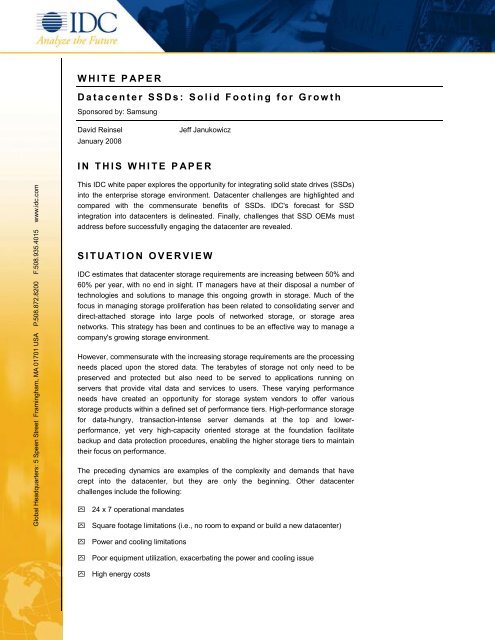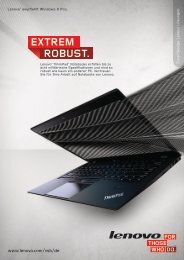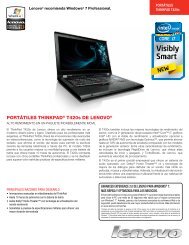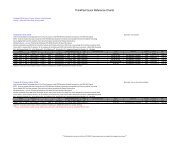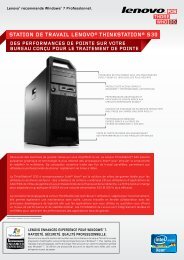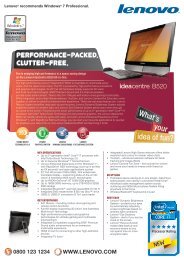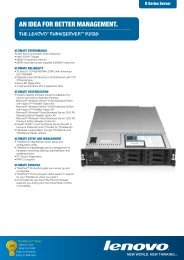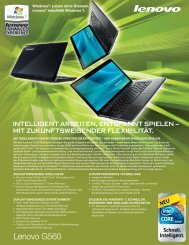WHITE PAPER Datacenter SSDs: Solid Footing for Growth IN THIS ...
WHITE PAPER Datacenter SSDs: Solid Footing for Growth IN THIS ...
WHITE PAPER Datacenter SSDs: Solid Footing for Growth IN THIS ...
Create successful ePaper yourself
Turn your PDF publications into a flip-book with our unique Google optimized e-Paper software.
Global Headquarters: 5 Speen Street Framingham, MA 01701 USA P.508.872.8200 F.508.935.4015 www.idc.com<br />
<strong>WHITE</strong> <strong>PAPER</strong><br />
<strong>Datacenter</strong> <strong>SSDs</strong>: <strong>Solid</strong> <strong>Footing</strong> <strong>for</strong> <strong>Growth</strong><br />
Sponsored by: Samsung<br />
David Reinsel Jeff Janukowicz<br />
January 2008<br />
<strong>IN</strong> <strong>THIS</strong> <strong>WHITE</strong> <strong>PAPER</strong><br />
This IDC white paper explores the opportunity <strong>for</strong> integrating solid state drives (<strong>SSDs</strong>)<br />
into the enterprise storage environment. <strong>Datacenter</strong> challenges are highlighted and<br />
compared with the commensurate benefits of <strong>SSDs</strong>. IDC's <strong>for</strong>ecast <strong>for</strong> SSD<br />
integration into datacenters is delineated. Finally, challenges that SSD OEMs must<br />
address be<strong>for</strong>e successfully engaging the datacenter are revealed.<br />
SITUATION OVERVIEW<br />
IDC estimates that datacenter storage requirements are increasing between 50% and<br />
60% per year, with no end in sight. IT managers have at their disposal a number of<br />
technologies and solutions to manage this ongoing growth in storage. Much of the<br />
focus in managing storage proliferation has been related to consolidating server and<br />
direct-attached storage into large pools of networked storage, or storage area<br />
networks. This strategy has been and continues to be an effective way to manage a<br />
company's growing storage environment.<br />
However, commensurate with the increasing storage requirements are the processing<br />
needs placed upon the stored data. The terabytes of storage not only need to be<br />
preserved and protected but also need to be served to applications running on<br />
servers that provide vital data and services to users. These varying per<strong>for</strong>mance<br />
needs have created an opportunity <strong>for</strong> storage system vendors to offer various<br />
storage products within a defined set of per<strong>for</strong>mance tiers. High-per<strong>for</strong>mance storage<br />
<strong>for</strong> data-hungry, transaction-intense server demands at the top and lowerper<strong>for</strong>mance,<br />
yet very high-capacity oriented storage at the foundation facilitate<br />
backup and data protection procedures, enabling the higher storage tiers to maintain<br />
their focus on per<strong>for</strong>mance.<br />
The preceding dynamics are examples of the complexity and demands that have<br />
crept into the datacenter, but they are only the beginning. Other datacenter<br />
challenges include the following:<br />
24 x 7 operational mandates<br />
Square footage limitations (i.e., no room to expand or build a new datacenter)<br />
Power and cooling limitations<br />
Poor equipment utilization, exacerbating the power and cooling issue<br />
High energy costs
These challenges are very real, and given today's economics, legacy paradigms are<br />
being challenged and are giving rise to new solutions from enterprise system<br />
vendors. The following are examples of some of the trends that have emerged<br />
significantly over the past few years:<br />
Server virtualization to increase server utilization and ease server management<br />
Server and storage blades to reduce server and storage footprints<br />
The use of high-capacity 7,200rpm hard disk drives (HDDs) to conserve energy<br />
Small <strong>for</strong>m factor (2.5in.) 10,000rpm and 15,000rpm drives to reduce HDD<br />
footprints as well as to increase enterprise HDD reliability<br />
In essence, many of the emerging trends within enterprise computing and storage are<br />
related to increasing per<strong>for</strong>mance, management, and efficiency. The evolution is not<br />
over, and IDC expects future advances to emerge with each passing year.<br />
The increasing focus on per<strong>for</strong>mance and efficiency has compelled system OEMs to<br />
investigate new strategies to achieve breakthrough advancements. One area that is<br />
capturing considerable attention is the use of <strong>SSDs</strong>.<br />
<strong>Solid</strong> state storage is not new when it comes to enterprise storage. DRAM-based<br />
storage solutions have been used <strong>for</strong> years to service those applications demanding<br />
the highest per<strong>for</strong>mance in terms of I/Os. However, until recently, the use of solid<br />
state storage in the datacenter has been very expensive. The rapid erosion of NAND<br />
flash over the past few years is enabling more af<strong>for</strong>dable solid state storage<br />
scenarios to emerge. IDC highlights some of the most promising enterprise<br />
applications <strong>for</strong> <strong>SSDs</strong>.<br />
Tier Zero Storage<br />
Today, most tiered storage strategies focus on bringing in lower tiers of storage<br />
focused on higher capacity and lower cost, but with lower per<strong>for</strong>mance. Until recently,<br />
traditional desktop-class HDDs were leveraged <strong>for</strong> this tier of datacenter storage.<br />
Reliability in the enterprise is paramount, so HDD vendors integrated enterprise-class<br />
features (e.g., rotational vibration sensors, advanced firmware) in these high-capacity<br />
drives to improve upon various metrics, including per<strong>for</strong>mance and reliability.<br />
Opposite this capacity-focused tier is a very high-per<strong>for</strong>mance tier, sometimes<br />
referred to as tier 0 (or zero). While 10,000rpm and 15,000rpm enterprise-class HDDs<br />
provide a significant per<strong>for</strong>mance boost over lower-tiered storage, <strong>SSDs</strong> can improve<br />
per<strong>for</strong>mance, specifically read per<strong>for</strong>mance, over the fastest HDDs by a factor of 10<br />
or more depending on the application and system configuration.<br />
2 #210290 ©2008 IDC
In 2006, 75% of the TBs shipped into enterprise storage were per<strong>for</strong>mance-optimized;<br />
the rest were capacity-optimized. By 2011, we believe the mix will nearly reverse, with<br />
35% per<strong>for</strong>mance and 65% capacity. However, this reduction in per<strong>for</strong>manceoptimized<br />
TBs should not impact the market <strong>for</strong> <strong>SSDs</strong> in this segment.<br />
Server Blades<br />
IT managers increasingly struggle with space constraints and server management<br />
and flexibility. Server blades help to bring more density and flexibility to the<br />
datacenter environment.<br />
The heightened focus on density is a perfect play <strong>for</strong> <strong>SSDs</strong> with their small <strong>for</strong>m factor<br />
and lower power and cooling requirements. In addition, the increased role of<br />
centralized storage can reduce the capacity requirements of an individual storage<br />
blade. For example, in some cases, server blades require only a boot drive (typically<br />
mirrored) with minimal capacity requirements. IDC notes, however, the growing<br />
popularity of server virtualization, which has had an opposite effect with respect to<br />
server storage (internal storage) requirements. The fact that a single physical server<br />
(pedestal, rack, or blade) can be deployed as multiple virtual servers increases the<br />
likelihood of more storage requirements, which can be met by leveraging small <strong>for</strong>m<br />
factor enterprise HDDs or <strong>SSDs</strong>, depending on the ultimate capacity, cooling, and<br />
power requirements.<br />
The industry shipped over 600,000 server blades in 2006 and over 700,000 blades in<br />
2007.<br />
Storage Blades<br />
As server blades grow in popularity, we expect storage blades to emerge in much the<br />
same way. Interestingly, storage blades can possess different levels of per<strong>for</strong>mance,<br />
in essence creating a tiered storage blade environment, which creates opportunities<br />
<strong>for</strong> very high-per<strong>for</strong>mance SSD-based blades. The market <strong>for</strong> storage blades is still<br />
nascent.<br />
In the end, we believe these areas provide a solid foundation <strong>for</strong> future datacenter SSD<br />
adoption and growth. Three key metrics helping to influence SSD adoption in the<br />
datacenter are per<strong>for</strong>mance, minimal capacity requirements, and power/cooling/space<br />
limitations.<br />
FUTURE OUTLOOK<br />
Capacity requirements <strong>for</strong> enterprise storage applications vary widely and can be<br />
influenced by a number of dynamics. Obviously, having a minimal role or workload,<br />
such as a boot drive, can provide an excellent opportunity <strong>for</strong> <strong>SSDs</strong>. Server OEMs<br />
already are offering <strong>SSDs</strong> as an option to traditional HDDs <strong>for</strong> server boot<br />
applications. Other applications favoring <strong>SSDs</strong> may include more commercial<br />
applications such as ATMs, manufacturing equipment, and other scenarios where the<br />
capacity requirements are minimal and the operating environment is more hostile.<br />
©2008 IDC #210290 3
Per<strong>for</strong>mance requirements differ widely among applications, as well. However, by<br />
tracking various server and storage workloads, it is possible to identify potential areas<br />
of adoption within a datacenter.<br />
IDC evaluates server and storage workloads annually. Figure 1 illustrates 2006<br />
storage capacity shipments by workload categories and by storage class (cost of<br />
storage system).<br />
FIGURE 1<br />
Storage Capacity Shipments by Workload and by Storage<br />
Class, 2006<br />
(PB)<br />
900<br />
800<br />
700<br />
600<br />
500<br />
400<br />
300<br />
200<br />
100<br />
0<br />
Source: IDC, 2007<br />
Business<br />
processing<br />
High-end<br />
Midrange<br />
Entry<br />
Decision<br />
support<br />
Collaborative Application<br />
development<br />
IT<br />
infrastructure<br />
Certain segments of the server and storage industry focus on extreme per<strong>for</strong>mance,<br />
one of the promises of <strong>SSDs</strong>. High-per<strong>for</strong>mance systems tend to be expensive,<br />
hence Figure 1 illustrates the size of potential per<strong>for</strong>mance-driven storage via the<br />
high-end storage class, or storage systems that sell <strong>for</strong> more than $300,000 and have<br />
a cost per GB in the $15–20 range. Customers focused on per<strong>for</strong>mance many times<br />
are willing to spend significant dollars on the highest-per<strong>for</strong>ming systems.<br />
Obviously, <strong>SSDs</strong> will not replace the massive HDD market, especially within the<br />
datacenter. However, a quick perusal of the various workloads suggests that a certain<br />
percentage of TBs possibly could be serviced by solid state storage, especially those<br />
in high-end storage arrays. For example, workloads such as Web infrastructures can<br />
experience very intense I/Os, and sometimes are unpredictable. Web sites with<br />
massive amounts of storage (content depots) can experience "hot spots" among the<br />
Web<br />
infrastructure<br />
Industrial<br />
R&D<br />
4 #210290 ©2008 IDC
spinning disks, <strong>for</strong>cing a storage balancing event that could impede per<strong>for</strong>mance and,<br />
worse yet, accelerate drive failures. Quickly offloading these high-demand TBs to an<br />
SSD tier zero not only could help eliminate the problem but also could prevent future<br />
issues and improve the per<strong>for</strong>mance and overall reliability of the infrastructure.<br />
Other workloads within the business processing and decision support categories,<br />
where response times are critical, can play to the strength of <strong>SSDs</strong>. Examples of such<br />
environments include the following: processing customer transactions (e.g., online<br />
reservations, stock transactions), looking up data (e.g., routing mobile telephone<br />
calls based on the cell phone number), or simply supporting some decision tree<br />
<strong>for</strong> some other infrastructure action. IDC expects <strong>SSDs</strong> will find their role throughout<br />
the datacenter and experience solid growth throughout the next several years<br />
(see Figure 2).<br />
FIGURE 2<br />
Enterprise SSD Unit Shipments and Revenue, 2006–2011<br />
Shipments (000)<br />
3,500<br />
3,000<br />
2,500<br />
2,000<br />
1,500<br />
1,000<br />
500<br />
0<br />
Source: IDC, 2007<br />
2006 2007 2008 2009 2010 2011<br />
Unit shipments<br />
Revenue<br />
1,400<br />
1,200<br />
1,000<br />
©2008 IDC #210290 5<br />
800<br />
600<br />
400<br />
200<br />
0<br />
Revenue ($M)
CHALLENGES<br />
<strong>Datacenter</strong>s are wrought with challenges that <strong>SSDs</strong> can help to overcome. However,<br />
it is never good to overcome one challenge and at the same time introduce another.<br />
IT managers and system OEMs alike also have requirements that must be met with<br />
respect to the hardware being deployed within the datacenter. Some of these<br />
requirements may pose a challenge to SSD vendors:<br />
Reputation. While cost per gigabyte is an important trait to PC and CE OEMs, it<br />
may not rank as high as vendor reputation among enterprise system OEMs. Cost<br />
is still important, but if there is a significant degradation in supply, per<strong>for</strong>mance,<br />
or reliability because of an inexperienced vendor and its manufacturing process,<br />
then the total downtime and lost business cost to an end user could be very high.<br />
As well, spoiling a system OEM's reputation can be devastating to the supplier of<br />
the server or storage system. Hence, system OEMs will tread carefully and<br />
conservatively until an SSD OEM is proven.<br />
Support. If component vendors have learned one lesson, it is that customer<br />
service is king to system OEMs. Companies such as Seagate, Intel, Brocade,<br />
and many others have dedicated staff that cater to their largest clients (system<br />
OEMs) to ensure that the necessary testing and qualifications are complete and<br />
that firmware is tweaked and optimized <strong>for</strong> the vendor, and they are willing and<br />
ready to respond to a critical failure or service call any time day or night. SSD<br />
OEMs will need to adopt similar strategies <strong>for</strong> enterprise system OEMs.<br />
Write reliability/per<strong>for</strong>mance. Most adept storage professionals understand the<br />
issues around writing to a solid state drive. Compared with traditional HDDs,<br />
most SSD designs have a write per<strong>for</strong>mance penalty when writing data. In<br />
addition, unlike HDD bits, SSD bits degrade over time from a "writability"<br />
perspective. The general rule is that an SSD single-level cell (SLC) bit is good up<br />
to 100,000 writes. The endurance of today's multilevel cell (MLC) flash typically is<br />
about one-tenth that of SLC flash.<br />
Cost per gigabyte. IDC does not expect solid state cost per gigabyte to ever<br />
have an advantage over HDDs. However, other requirements such as<br />
per<strong>for</strong>mance, ruggedness, and low power can trump the cost premium and<br />
create opportunities <strong>for</strong> integration.<br />
6 #210290 ©2008 IDC
CONCLUSION<br />
<strong>SSDs</strong> will be adopted into the datacenter much more aggressively in the future than<br />
they were in the past. Currently, IDC estimates that over 3 million <strong>SSDs</strong> will be<br />
shipped into enterprise applications, creating a $1.2 billion opportunity by 2011.<br />
We believe the best opportunity <strong>for</strong> SSD adoption lies within I/O-intense applications<br />
where a direct correlation exists between higher per<strong>for</strong>mance and higher revenue.<br />
<strong>SSDs</strong> will capture not only a percentage of TBs normally serviced by enterprise-class<br />
HDDs but also a percentage of TBs from existing DRAM-based storage systems<br />
where flash <strong>SSDs</strong> can offer similar per<strong>for</strong>mance, but at a much reduced cost per<br />
gigabyte. Replacing low-capacity workloads, such as server boot drives, also offers a<br />
compelling opportunity <strong>for</strong> <strong>SSDs</strong> in the datacenter. Finally, <strong>for</strong> dense solutions, <strong>SSDs</strong><br />
are a natural fit with blade architectures.<br />
The challenges are real, but if they are addressed appropriately, we believe<br />
businesses, as well as their customers, will benefit from the numerous advantages<br />
associated with SSD adoption within the datacenter.<br />
Copyright Notice<br />
External Publication of IDC In<strong>for</strong>mation and Data — Any IDC in<strong>for</strong>mation that is to be<br />
used in advertising, press releases, or promotional materials requires prior written<br />
approval from the appropriate IDC Vice President or Country Manager. A draft of the<br />
proposed document should accompany any such request. IDC reserves the right to<br />
deny approval of external usage <strong>for</strong> any reason.<br />
Copyright 2008 IDC. Reproduction without written permission is completely <strong>for</strong>bidden.<br />
©2008 IDC #210290 7


